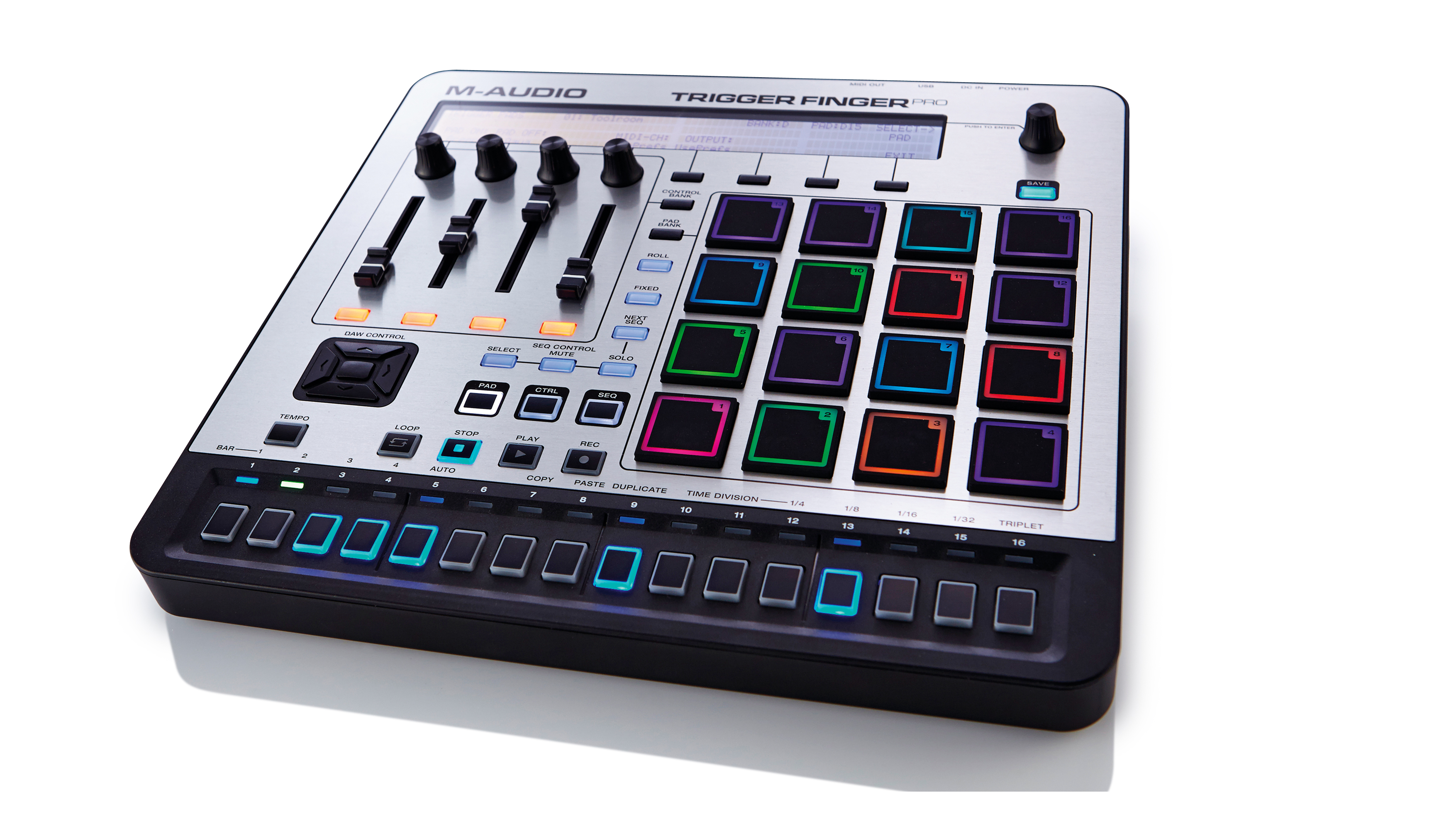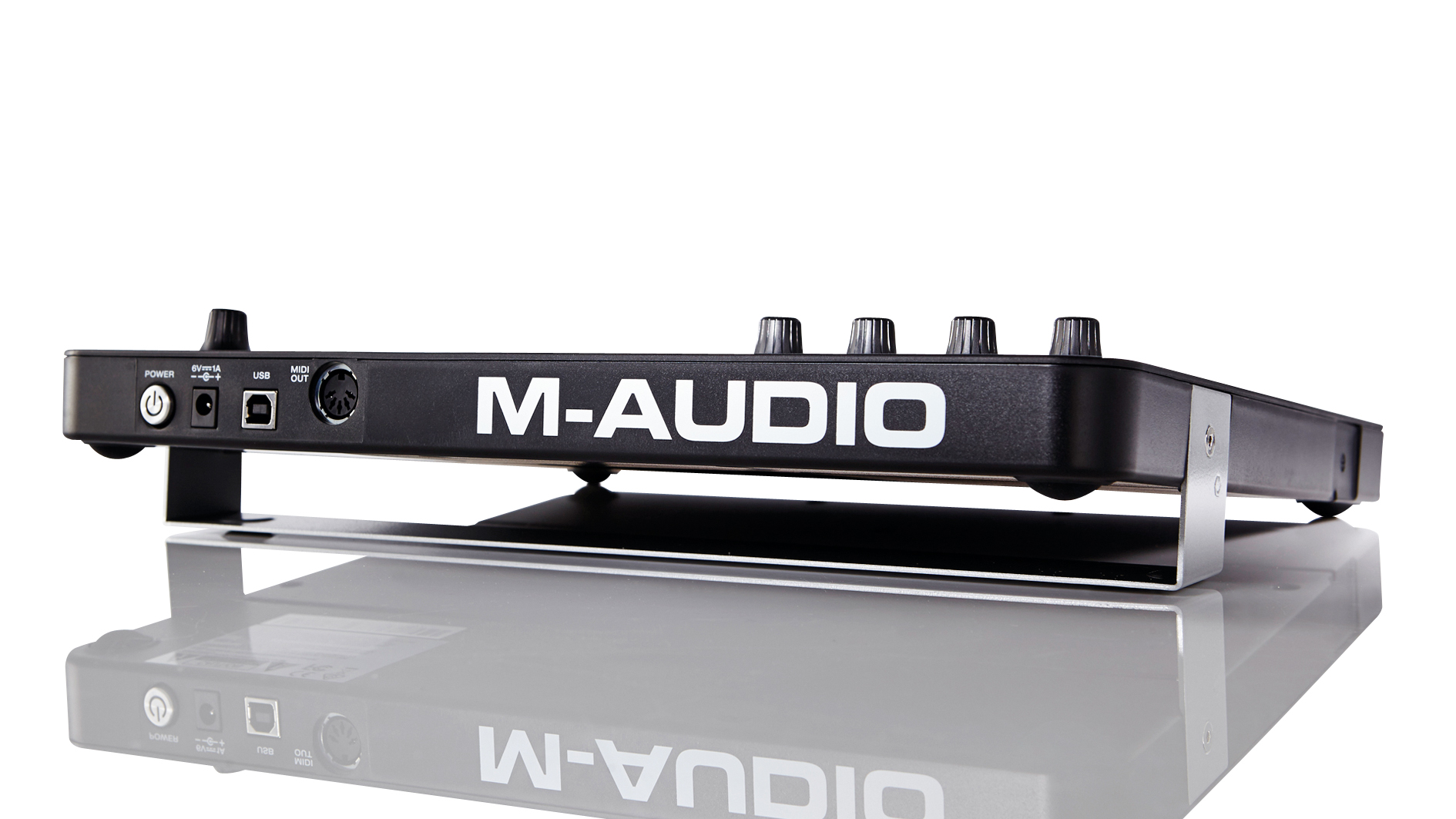MusicRadar Verdict
In combination with the bundled software, it is an inspiring, creative hybrid sequencing platform.
Pros
- +
Intuitive onboard real-time and step-time sequencer. Independent pads and control banks provide huge performance possibilities. Generous software content offered via downloads at no extra cost.
Cons
- -
Nothing.
MusicRadar's got your back

TFP

Trigger Finger Pro
M-Audio released Trigger Finger around a decade ago, and it was one of the first MIDI control surfaces to ditch a keyboard in favour of pads, rotaries and sliders. These could be configured to send MIDI control information to hardware or software; but the landscape of music production has changed enormously in that time.
"Trigger Finger Pro bears so little relation to its predecessor that it deserves to be considered as a new product"
M-Audio's range of keyboard controllers are reflective of these changes, now packed with more tactile controls than ever before. All of which means that an overhaul of Trigger Finger is long overdue. The great news is that it's now here in the form of Trigger Finger Pro, which bears so little relation to its predecessor that it deserves to be considered almost as a new product.
Take a Trigger tour
Trigger Finger Pro (TFP) is a hardware/ software hybrid that uses a square, silver and black control surface to act as a trigger and control front-end to a range of software titles to which its purchase provides access. At the heart of TFP is a sequencer to which lanes of sounds can be added that, in turn, can be triggered from the control surface's pads and manipulated from its onboard sliders and dials.
To stress - this hybrid relationship is essential; TFP features no audio outputs and doesn't store its sounds internally. So whilst, over MIDI, it can trigger external gear and, via USB, it's designed for integration within a DAW to work with software instruments, it's not a standalone production workstation.
For those twin purposes, the rear panel has both a five-pin MIDI Out port and a USB connection socket, with a power button next to the DC power inlet. As TFP is buss-powered, you may not need the latter connector and there's no power supply in the box. However, you will need one if you want to use the surface as a controller for external MIDI gear without a computer.
The upper panel is where the action happens. It's dominated by a large backlit LCD screen at the top and an MPC style pad matrix on the right-hand side where 16 pads can be triggered in groups of four banks, giving you access to 64 sounds (or parameters) to be triggered at once. Brilliantly, these pads are both velocity and aftertouch sensitive. The pad banks are back-lit with different colours so scrolling through them - and keeping track of which bank you're playing - is easy.
There is a further series of buttons running along the bottom edge of the control surface too and this provides access to the sequencer. In classic 909 style, when a sequence is running, lights show you where you are in a pattern, whilst hitting one of these pads to add a new note event to a sequence illuminates its light 'solidly'. As a sequence moves from one bar to the next, so the lights keep track, all of which means that programming patterns here is super-intuitive.
Under the fingers
A TFP preset represents the highest stage of a collection of active sounds, so programming a sequence is most easily done by picking one of these. Its associated sounds are then mapped to the pads and programming a sequence involves clicking a pad to make it the active element, before tapping on the sequencer's pads to place an event in the place where you want it. You can either record in step-time in this way, or trigger pads on the fly in Record mode.
Once you've got a sequence running, you can adjust a range of parameters for it. A Swing value sets a global offset whilst editing velocity presents each step with its own strength value, ready for you to adjust the default step-time input value of 127 for a lower number of your choice.
Conversely, if you're recording in real time but don't want velocity to play a role in your real- time tappings, you can enable the Fixed button, to ensure that all events are created with the same value. Meanwhile a Roll function can be enabled to allow you to create rapid-repeat playback of any pad you hit - a great way to create anything from snare fills to glitched-up stutters of any sound you trigger.
"It ships with so much software content that you'll need weeks to exhaust the sound sets"
There are pad Solo and Mute buttons too, either enabling you to drop parts out temporarily, or focus on the sounds of just one, with the pads allowing you to include or exclude any sounds from your sequence with a single press. So, if you want to hear your loop without the kick and snare at the same time, just hit Mute whilst triggering both those pads; they'll stay silent until you tap them again to reintroduce them.
The four rotary controls, sliders and buttons also work on a bank-based system which is independent from the pad banks. The Arsenal software allows you to pick a parameter for each physical control from a comprehensive list, or to Learn an assignment over MIDI, which is great if you're using TFP with your own plug-ins.
Using the Control Bank button, you can cycle through the four banks, effectively providing 16 sliders and buttons to be used in real time. As with the pads, the buttons glow in different back-lit colours to show which one is active at any time.
Trigger Finger Pro is a triumph. It ships with so much software content that you'll need weeks to exhaust the sound sets and, in the meantime, you can perfect your sequencing skills. The hardware makes programming and tweaking a joy and, with the backlit colours for pads and Control parameters, you'll quickly learn how to keep on top of your settings. A classic is reborn.
With its latest free update, Ableton has finally turned Note into the app I always wanted it to be
Technically capable, but struggle to make your tunes sound musical? 5 simple music theory hacks to make your tracks stand out
"Despite its size, it delivers impressive audio quality and premium functions as well as featuring a good selection of inspired sounds": Roland GO:Piano 88PX review









